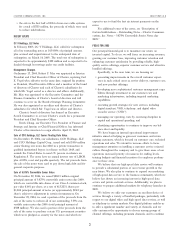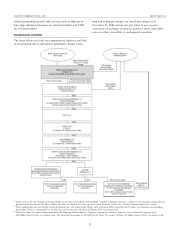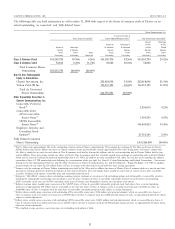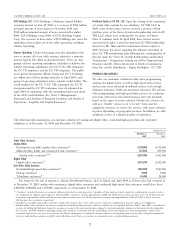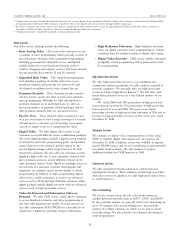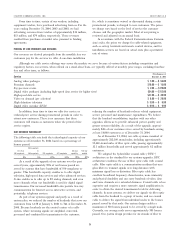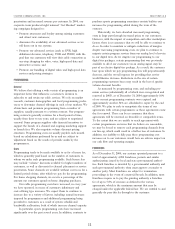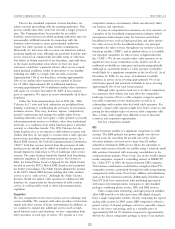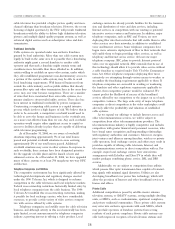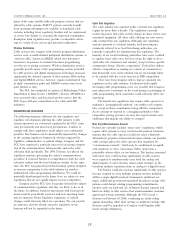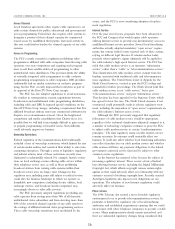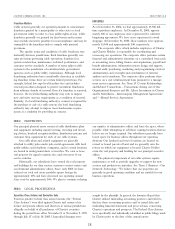Charter 2004 Annual Report Download - page 22
Download and view the complete annual report
Please find page 22 of the 2004 Charter annual report below. You can navigate through the pages in the report by either clicking on the pages listed below, or by using the keyword search tool below to find specific information within the annual report.
CHARTER COMMUNICATIONS, INC. 2004 FORM 10-K
Prior to the scheduled expiration of most franchises, we competitive business environment, which can adversely affect
initiate renewal proceedings with the granting authorities. This our business and operations.
process usually takes three years but can take a longer period of In terms of competition for customers, we view ourselves as
time. The Communications Act provides for an orderly a member of the broadband communications industry, which
franchise renewal process in which granting authorities may not encompasses multi-channel video for television and related
unreasonably withhold renewals. In connection with the broadband services, such as high-speed data and other interac-
franchise renewal process, many governmental authorities tive video services. In the broadband industry, our principal
require the cable operator to make certain commitments. competitor for video services throughout our territory is direct
Historically we have been able to renew our franchises without broadcast satellite (‘‘DBS’’), and in markets where it is available,
incurring significant costs, although any particular franchise may our principal competitor for data services is digital subscriber
not be renewed on commercially favorable terms or otherwise. line (‘‘DSL’’). We do not consider other cable operators to be
Our failure to obtain renewals of our franchises, especially those significant one-on-one competitors in the market overall, as
in the major metropolitan areas where we have the most traditional overbuilds are infrequent and spotty geographically
customers, could have a material adverse effect on our consoli- (although in a particular market, a cable operator overbuilder
dated financial condition, results of operations or our liquidity, would likely be a significant competitor at the local level). As of
including our ability to comply with our debt covenants. December 31, 2004, we are aware of traditional overbuild
Approximately 11% of our franchises, covering approximately situations in service areas covering approximately 5% of our
10% of our analog video customers were expired at Decem- total homes passed and potential overbuilds in areas servicing
ber 31, 2004. Approximately 8% of additional franchises, approximately 2% of our total homes passed.
covering approximately 9% of additional analog video customers Although cable operators tend not to be direct competitors
will expire on or before December 31, 2005, if not renewed for customers, their relative size may affect the competitive
prior to expiration. We expect to renew substantially all of these
landscape in terms of how a cable company competes against
franchises.
non-cable competitors in the market place as well as in
Under the Telecommunications Act of 1996 (the ‘‘1996
relationships with vendors who deal with cable operators. For
Telecom Act’’), state and local authorities are prohibited from
limiting, restricting or conditioning the provision of telecommu- example, a larger cable operator might have better access to and
nications services. They may, however, impose ‘‘competitively pricing for the multiple types of services cable companies offer.
neutral’’ requirements and manage the public rights-of-way. Also, a larger entity might have different access to financial
Granting authorities may not require a cable operator to provide resources and acquisition opportunities.
telecommunications services or facilities, other than institutional Our key competitors include:
networks, as a condition of an initial franchise grant, a franchise DBS
renewal, or a franchise transfer. The 1996 Telecom Act also Direct broadcast satellite is a significant competitor to cable
limits franchise fees to an operator’s cable-related revenues and systems. The DBS industry has grown rapidly over the last
clarifies that they do not apply to revenues that a cable operator
several years, far exceeding the growth rate of the cable
derives from providing new telecommunications services. In a
television industry, and now serves more than 24 million
March 2002 decision, the Federal Communications Commission
subscribers nationwide. DBS service allows the subscriber to
(‘‘FCC’’) held that revenue derived from the provision of cable
modem service should not be added to franchise fee payments receive video services directly via satellite using a relatively small
already limited by federal law to 5% of traditional cable service dish antenna. Consistent with increasing consolidation in the
revenue. The same decision tentatively limited local franchising communications industry, News Corp., one of the world’s largest
authority regulation of cable modem service. On October 6, media companies, acquired a controlling interest in DIRECTV,
2003, the United States Court of Appeals for the Ninth Circuit Inc. (‘‘DirecTV’’) in 2003, the largest domestic DBS company.
vacated in part the FCC’s March 2002 decision and remanded This business combination could further strengthen DirecTV’s
for further proceedings. The Ninth Circuit affirmed the portion competitive posture, particularly through favorable programming
of the FCC’s March 2002 decision holding that cable modem arrangements with various News Corp. affiliates and subsidiaries,
service is not a ‘‘cable service.’’ Although the Ninth Circuit’s such as the Fox television network. Additionally, EchoStar and
decision should not subject cable operators to additional cable DirecTV both have entered into joint marketing agreements
franchise fee requirements for the provision of cable modem with major telecommunications companies to offer bundled
service, it could possibly result in other telecommunications packages combining phone service, DSL and DBS services.
regulation. Video compression technology and high powered satellites
Competition allow DBS providers to offer more than 200 digital channels
We face competition in the areas of price, service offerings, and from a single transponder satellite, thereby surpassing the typical
service reliability. We compete with other providers of television analog cable system. In 2003, major DBS competitors offered a
signals and other sources of home entertainment. In addition, as greater variety of channel packages, and were especially compet-
we continue to expand into additional services such as high- itive at the lower end pricing, such as a monthly price of
speed Internet access and telephony, we face competition from approximately $30 for 75 channels compared to approximately
other providers of each type of service. We operate in a very $40 for the closest comparable package in most of our markets.
12


